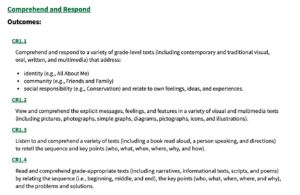Teaching Digital Literacy to Primary Students
I have always wanted to teach the primary grades, from the beginning of my degree I have been saying my focus is placed in Kindergarten to Grade Two. This hope has been solidified by my Pre-Internship in a Grade One classroom. I hope this love will also continue for me in my Fall Internship where I have been placed in a Kindergarten classroom. Though I find the younger grades so exciting and know there is so much learning to begin with these ages, I have also began to think about how to integrate digital literacy into lessons. For younger students there is much less of a chance that they are reading the news or engaging in social media, but even though it is unlikely it is not impossible. I believe that laying down the foundation of what digital literacy looks like is crucial with the youngest of students, in order for them to grow up to be digitally literate and responsible people. In this post I will discuss my intentions surrounding teaching digital literacy to younger students.
Digital Literacy in The Curriculum
When looking at the Grades One and Two curriculums, I was immediately drawn to the Comprehend and Respond outcomes. I think these outcomes could be really great for teaching digital literacy because they place focus on what the text is trying to convey.

- “Explore[ing] and engage critically, thoughtfully, and across a wide variety of inclusive texts and tools/modalities” – through approaching a variety of information and resources on the internet.
- “Determine how and to what extent texts and tools amplify one’s own and others’ narratives as well as counter unproductive narratives” – by comparing texts to one another.
- “Recognize and honour the multilingual literacy identities and culture experiences individuals bring to learning environments, and provide opportunities to promote, amplify, and encourage these differing variations of language” – by discussing with others and understanding a variety of perspectives.
(NCTE Definition of Literacy in a Digital Age)
Using Resources to Teach Digital Literacy
Of course when teaching digital literacy technology is important. So, as teachers it is our job to find resources that work well for students in teaching this concept. I class we discussed a commonly used resource, the Pacific Northwest Tree Octopus website. This site is not a great resource for teaching because it is not realistic. As discussed in the article How do we teach students to identify fake news it is discussed that it is important to bring forward things students would realistically come across in their day to day technology use. So things like the octopus are not really relevant to them. So, I feel looking at things like real news articles with opposing information, or examples of social media posts would be much more beneficial. Teachers could use resources like the Can You Spot the Fake News Headline? Quiz, or the Spot The Troll Quiz.